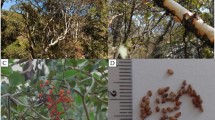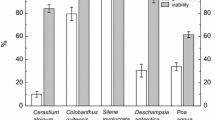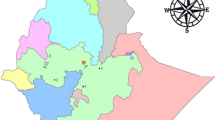Abstract
The aim of this study was to evaluate seed viability and germination in Agave angustifolia subsp. tequilana and A. mapisaga; two cultivated species. We hypothesized that seed viability may have been altered differentially due to different patterns of human impact and seed germination at a wide range of temperatures is related to their respective natural distribution. The biochemical tetrazolium test and germination assays in petri dishes at 15, 20, 25, 30 and 35 °C were carried out. Species and temperature factors were tested using a fixed-effects ANOVA and mean germination time (G50) and the time between 10 and 90 % (G10−90) of germination potential after 30 d were analyzed by applying a Tukey test. Based on the results from tests showing seed viability, seeds were classified as viable, unviable or lacking embryo seeds, and seed viability was considered a random effect. Agave angustifolia subsp. tequilana had a higher (p < 0.05) proportion of unviable seeds (50 %) as well as seeds which lacked embryo (28 %), whereas almost 70 % of A. mapisaga seeds were viable and only 1 % lacked embryos. Germination in A. mapisaga reached around 70 % at 15, 20, 25 and 35 °C. Germination of A. angustifolia subsp. tequilana was 28 % on average only at 25, 30 and 35 °C, at the other temperatures it was significantly lower or zero. Germination first initiated in A. mapisaga, with a statistically higher rate than in A. angustifolia subsp. tequilana. Low germination, a high proportion of unviable seeds as well as lack of embryo in A. angustifolia subsp. tequilana may be attributes intrinsic to this clone, which was selected for its precocity, high yield and distinctive blue color. Better germination in A. mapisaga at different temperatures and a high degree of seed viability may be desirable in a species selected for peasant or nonintensive traditional systems, and may indicate less humanization than that manifested by A. angustifolia subsp. tequilana.






Similar content being viewed by others
References
Aguirre JR, Charcas ZH, Flores FJL (2001) El maguey mezcalero potosino. COPOCYT-UASLP, San Luis Potosí, México
Alfaro-Rojas G, Legaria-Solano JP, Rodríguez-Pérez JE (2007) Genetic diversity in populations of pulquero agaves (Agave spp.) in northeastern México state. Rev Fitotec Mex 30:1–12
AOSA (1983) Seed vigor testing handbook. Contribution No. 32. Association of Official Seed Analysis, Nebraska, Lincoln
Arizaga S, Ezcurra E (2002) Propagation mechanisms in Agave macroacantha (Agavaceae), a tropical arid land succulent rosette. Am J Bot 89:63–641
Bonnave M, Bleeckx G, Rojas J, Maughan BP, Flamand MC, Terrazas F, Bertin P (2014) Farmers’ unconscious incorporation of sexually-produced genotypes into the germplasm of a vegetatively-propagated crop (Oxalis tuberosa Mol.). Genet Resour Crop Evol 61:721–740
Bowen S, Valenzuela-Zapata A (2009) Geographical indications, terroir, and socioeconomic and ecological sustainability: the case of tequila. J Rural Stud 25:108–119
Callen EO (1967) Analysis of the Tehuacán coprolites. In: Byers DS (ed) The prehistory of the Tehuacán Valley. Environment and subsistence. University of Texas, Austin, pp 261–289
Colunga-GarcíaMarín P, Estrada-Loera E, May-Pat F (1996) Patterns of morphological variation, diversity, and domestication of wild and cultivated populations of Agave in Yucatan, Mexico. Am J Bot 83:1069–1082
Colunga-GarcíaMarín P, Coello-Coello J, Eguiarte LE, Piñero D (1999) Isoenzymatic variation and phylogenetic relationships between henequén (Agave fourcroydes) and its wild ancestor A. angustifolia (Agavaceae). Am J Bot 86:115–123
Colunga-GarcíaMarín P, Zizumbo-Villareal D, Martínez-Torres J (2007) Tradiciones en el aprovechamiento de los agaves mexicanos: una aportación a la protección legal y conservación de su diversidad biológica y cultural. In: Colunga-GarcíaMarín P, Larqué SA, Eguarte LE, Zizumbo-Villareal D (eds) En lo ancestral hay futuro: del tequila, los mezcales y otros agaves. Centro de Investigación Científica de Yucatán, Mérida, México, pp 229–248
Escobar-Guzmán RE, Hernández FZ, Vega KG, Simpson J (2008) Seed production and gametophyte formation in Agave tequilana and Agave americana. Irapuato, Guanajuato, Mexico. Botany 86:1343–1353
Espinosa PH, Arredondo VC, Cano GM, Vásquez QF, Canseco LA (2002) La materia prima para producir mezcal oaxaqueño, catalogo de la diversidad de agaves. Instituto Nacional de Investigaciones Agrícolas Forestales y Pecuarias, Oaxaca, México
Espinosa PH, Bravo ME, López LP, Arredondo VC (2005) El agave mezcalero de Oaxaca. Avances de investigación. Libro Técnico Núm. 3. Instituto de Investigaciones Forestales Agrícolas y Pecuarias, Oaxaca, México
Figueredo CJ, Casas A, Colunga-GarcíaMarín P, Nassar JM, González-Rodríguez A (2014) Morphological variation, management and domestication of ‘maguey alto’ (Agave inaequidens) and ‘maguey manso’ (A. hookeri) in Michoacán, México. Ethnobiol Ethnomed 10:1–12
Flores J, Jurado E, Arredondo A (2006) Effect of light on germination of seeds of Cactaceae from the Chihuahuan Desert, Mexico. Seed Sci Res 16:149–155. doi:10.1079/SSR2006242
Freeman CE, Tiffany RS, Reid WH (1977) Germination responses of Agave lechuguilla, A. parryi, and Fouqueria splendens. Southwest Nat 22:195–204
Gentry HS (1982) Agaves of continental North America. The University of Arizona Press, Tucson
Gil-Vega K, González CM, Martínez de la Vega O, Simpson J, Vandemark G (2001) Analysis of genetic diversity in Agave tequilana var. azul using RAPD markers. Euphytica 119:335–341
González-Elizondo M, Galván-Villanueva R, López-Enríquez IL, Resendiz-Rojas L, González-Elizondo MS (2009) Agaves, magueyes, lechuguillas y noas del estado de Durango y sus alrededores. Centro Interdisciplinario de Investigación para el Desarrollo Integral Regional, Instituto Politécnico Nacional, Durango, México
Grabe DF (1970) Tetrazolium testing handbook for agricultural seeds. Contribution Number 29 to the Handbook on seed testing. Association of Official Seed Analysts, North Brunswick, New Jersey, USA. 62p
Granados D (1993) Los agaves en México. Universidad Autónoma Chapingo, Chapingo
Harlan JR (1992) Crops and man, 2nd edn. ASA and CSSA, Madison, Wisconsin
Harris DR (1989) An evolutionary continuum of people-plant interaction. In: Harris DR, Hillman GC (eds) Foraging and farming. Unwin Hyman, Londres, pp 11–26
Kennedy J (2008) Pacific bananas: complex origins, multiple dispersals? Asian Perspect 47:75–94
Macías MA, Valenzuela-Zapata AG (2009) El tequila en tiempos de la mundialización. Comercio Exterior 59:459–472
McKey D, Elias M, Pujol B, Duputié A (2010) The evolutionary ecology of clonally propagated domesticated plants. New Phytol 186:318–332
Mora-López JL, Reyes-Agüero JA, Flores-Flores JL, Peña-Valdivia CB, Aguirre-Rivera JR (2011) Morphological variation and humanization of Agave genus, Salmianae section. Agrociencia 45:465–477
Núñez-Noriega L (2001) La producción de mezcal bacanora, una oportunidad económica para Sonora. Centro de investigación en alimentación y desarrollo, AC, Hermosillo, México
Olea FR (2010) De una singular leche alabastrina: el pulque en la literatura mexicana del siglo XIX. Lit Mex 21:203–223
Parsons JR, Parsons AH (1990) Maguey utilization in highland central México: an archaeological ethnography. University of Michigan, Ann Arbor, Illinois
Peña-Valdivia CB, García NR, Aguirre RJR, Trejo C (2002) The effects of high temperature on dormancy and hypocotyl-root growth of wild common bean (Phaseolus vulgaris L.). Seed Sci Technol 30:231–248
Peña-Valdivia CB, Sánchez-Urdaneta AB, Aguirre RJR, Trejo C, Cárdenas E, Villegas MA (2006) Temperature and mechanical scarification on seed germination of `maguey´ (Agave salmiana Otto ex Salm-Dyck). Seed Sci Technol 34:47–56
Perales HR, Aguirre JR (2008) Biodiversidad humanizada. In: Capital natural de México, vol. I: Conocimiento actual de la biodiversidad. Comisión Nacional para el Conocimiento y uso de la Biodiversidad (CONABIO), México, pp 565–603
Pill WG, Kilian EA (2000) Germination and emergence of parsley in response to osmotic or matric seed priming and treatment with gibberellin. HortScience 35:907–909
Piven NM, Barredo-Pool FA, Borges-Argáez IC, Herrera-Alamillo MA, Mayo-Mosqueda A, Herrera-Herrera JL, Robert ML (2001) Reproductive biology of henequen (Agave fourcroydes) and its wild ancestor Agave angustifolia (Agavaceae). I. Gametophyte development. Am J Bot 88:1966–1976. doi:10.2307/3558424
Pritchard HW, Miller AP (1995) The effects of constant temperatures, light and seed quality on the germination characteristics of Agave americana. Bol Soc Bot Méx 57:11–14
Ramírez-Tobías HM, Peña-Valdivia CB, Aguirre RJR, Reyes-Agüero JA, Sánchez-Urdaneta AB, Valle GS (2012) Seed germination temperatures of eight Mexican Agave species with economic importance. Plant Species Biol 27:124–137
Ramírez-Tobías HM, Peña-Valdivia CB, Aguirre RJR (2014a) Respuestas bioquímico-fisiológicas de Agave spp. a la restricción de humedad. Bot Sci 92:131–139
Ramírez-Tobías HM, Peña-Valdivia CB, Trejo C, Aguirre RJR, Vaquera H (2014b) Differential effects of substrate water potential on seed germination of seven Agave species. Biol Res 47:11. doi:10.1186/0717-6287-47-11
Ruvalcaba MJ (1983) El maguey manso: historia y presente en Epazoyucan. Universidad Autónoma Chapingo, México, Hidalgo
Ruvalcaba-Ruiz D, Rodríguez-Garay V (2002) Aberrant meiotic behavior in Agave tequilana Weber var. azul. BMC Plant Biol 2:10
Valenzuela-Zapata AG (2003) El agave tequilero, cultivo e industria de México. Mundi-Prensa, México
Valenzuela-Zapata AG, Nabhan GP (2004) Tequila: a natural and cultural history. The University of Arizona Press, Tucson
Vargas-Ponce O, Zizumbo-Villarreal D, Colunga-GarcíaMarín P (2007) In situ diversity and maintenance of traditional Agave landraces used in spirits production in west-central Mexico. Econ Bot 61:362–375
Zohary D (2004) Unconscious selection and the evolution of domesticated plants. Econ Bot 58:5–10
Acknowledgments
We would like to thank Dr. José Luis Flores Flores and Dra. Erika García Chavez for use of their germination chamber and also for providing access to their lab. We also recognize Dra. Claudia González Salvatierra for her contribution to the viability test. Caroline Karslake improved the English wording of manuscript, thanks. This research was partially funded by the project PROMEP/103.5/11/6650 (Secretaría de Educación Pública, México).
Author information
Authors and Affiliations
Corresponding author
Rights and permissions
About this article
Cite this article
Ramírez Tobías, H.M., Niño Vázquez, R., Aguirre Rivera, J.R. et al. Seed viability and effect of temperature on germination of Agave angustifolia subsp. tequilana and A. mapisaga; two useful Agave species. Genet Resour Crop Evol 63, 881–888 (2016). https://doi.org/10.1007/s10722-015-0291-x
Received:
Accepted:
Published:
Issue Date:
DOI: https://doi.org/10.1007/s10722-015-0291-x




